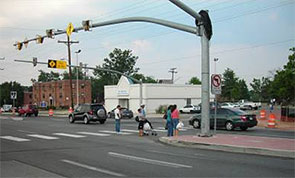A fine line: Langley Park’s planned redevelopment
It’s rare that an area so physically suburban already possesses the people element of a thriving urban center. It might be counterintuitive to think that improving transit to such an area could negatively impact that vibrancy. But this is the threat Prince George’s redevelopment plan around poses to Langley Park. The Purple Line will bring positive effects to the community, but the County’s insensitive plans for redeveloping the area around the planned station could shred the existing community fabric and leave many residents worse off.
Driving through the crossroads of New Hampshire Avenue and University Boulevard, a passerby might observe the massive parking lots surrounding the wide, traffic choked intersection and notice only the seemingly empty blight caused by decades of car-only planning. Making the area a lively public space seems has fallen by the wayside, overlooked by the State of Maryland and Montgomery and Prince George’s Counties in favor of moving cars along the two massive traffic sewers as fast as possible.


Kids and streets of Langley Park. Photos by Casa de Maryland and CSG.
But the people are indeed present. Despite an unsafe pedestrian environment, they are walking about the area in full force. They are walking to the locally owned businesses and diverse ethnic restaurants that reflect the Indian, Pakistani, Vietnamese, Cambodian, Caribbean, West African, and perhaps most notably Central American cultures that enliven these crossroads. They are walking to the bus stop to ride one of the eleven bus lines that runs through the area. They are walking to affordable apartments in the Hampshire Village and Willowbrook neighborhoods. While future plans to bring the Purple Line and a bus station to the area will make the walking easier, they will be endangering the presence of the people walking and many of their destinations.
The physical layout of Langley Park is dismal. Huge parking lots, wide roads with fast moving traffic, and inconsistent pedestrian facilities make navigating the area difficult. Traffic at peak hours is so unbearable that it is a small miracle the crossroads will not meet the same clover-leafed fate as other traffic-choked intersections in suburban Maryland. Instead, salvation is coming in the form of more transit capabilities, a bus depot (PDF) and the Purple Line. Both Montgomery County and Prince George’s County have proposals to reconfigure their portions of the area into safer, more convenient environs, increasing the number of businesses and the housing stock in the process. Absent from Prince George’s plan, however, are adequate measures to keep from pricing out the residents and businesses already present in the area.
There is growing concern by the residents and businesses of the area. The new development will certainly make the area cleaner, safer, and more connected, but can it be done without pricing out the working class residents that make up a significant portion of the population? For transit-oriented development to work, planners must address this issue before rezoning properties and commencing development. Otherwise, property values could skyrocket and the people that were supposed to benefit from the changes are instead forced out of their community. This is one of the major criticisms of Smart Growth, but it does not have to be the case. Unfortunately for many (including myself), it is very easy to look at this area needing physical redevelopment and overlook the prospect of displacing the people that live there.


Left: Current Takoma/Langley land use. Right: Proposed land use in Prince George’s County.
Click on an image to enlarge (PDF).
Jews United For Justice, a local organization, has been actively campaigning to bring this issue to the attention of planners from both counties. Four Prince George’s County rabbis sent an open letter to the county hearing board urging them to incorporate affordable housing into the plan, and to prevent the displacement of the residents of Langley Park. Echoing these sentiments, JUFJ has set up a letter writing campaign. The central theme of the letter is simple:
The Langley Park Sector Plan should improve the economic and social fortunes of Langley Park, keeping the vibrant character of the community alive.
This notion rings true for any redevelopment. When the residents of an area are priced out of their homes and businesses, we have not improved an area. We have made a new area and disregarded the original population. They call on Prince George’s County to set aside some of the retail space in new development for the local, ethnic businesses that the development will displace. They ask the County to ensure adequate affordable housing in development that replaces or displaces current residents, and preserve existing apartments where possible. The current plan rezones all areas containing multifamily, mostly rental housing, while declaring the nearby wealthier, more owner-occupied single-family areas “stable” and thus untouchable.
Immigrants, the working class, and locally owned businesses can most benefit from the transit-oriented development that can spring up around the Purple Line. However, we must pay careful attention to how we treat the residents and businesses of Langley Park. If we fail to protect these residents and businesses, what is now Langley Park will disappear. It will set an important precedent for future development, and it will send a powerful message to residents of other areas about how they will be treated when redevelopment comes to their neighborhood.
